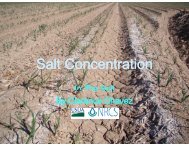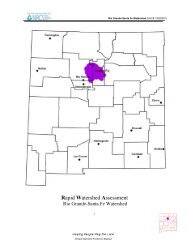SAMPLING VEGETATION ATTRIBUTES - New Mexico NRCS - US ...
SAMPLING VEGETATION ATTRIBUTES - New Mexico NRCS - US ...
SAMPLING VEGETATION ATTRIBUTES - New Mexico NRCS - US ...
Create successful ePaper yourself
Turn your PDF publications into a flip-book with our unique Google optimized e-Paper software.
12<br />
STUDY DESIGN AND ANALYSIS<br />
Because the quadrats are being placed with their long side parallel to<br />
the x-axis, the coordinates are ordered first by the x-axis and next by<br />
the y-axis. Thus the new order is as follows:<br />
x-axis y-axis<br />
1. 16.0 m 28.0 m<br />
2. 48.0 m 8.0 m<br />
3. 48.0 m 27.0 m<br />
4. 64.0 m 34.0 m<br />
In each column defined by an x-coordinate, sampling starts from the<br />
bottom of the macroplot and moves to the top. This systematic<br />
approach ensures that quadrats are not walked on until after they have<br />
been read.<br />
c Linear This study design samples a study site in a straight line. Because it<br />
samples such a small segment of the sample area, this technique is not<br />
recommended except for long, narrow study sites such as riparian areas.<br />
Randomly select the beginning point of the transect within the study site and<br />
mark it with a stake to permanently locate the transect (figure 4). Randomly<br />
determine the transect bearing and select a prominent distant landmark such as<br />
a peak, rocky point, etc., that can be used as the transect bearing point. Vegetation<br />
attribute readings are taken at a specified interval (paced or measured)<br />
along the transect bearing. If the examiner is unable to collect an adequate<br />
sample with this transect before leaving the study site, additional transects can<br />
be run from the transect location stake at different bearings.<br />
B. Statistical Considerations<br />
1. Target Population Study sites are selected (subjectively) that hopefully reflect<br />
what is happening on a larger area. These may be areas that are considered to be<br />
representative of a larger area such as a pasture (see Section II.D.2 for more discussion<br />
of key areas) or critical areas such as sites where endangered species occur.<br />
Monitoring studies are then located in these areas. Since these study sites are<br />
subjectively selected, no valid statistical projections to an entire allotment are<br />
possible. Therefore, careful consideration and good professional judgement must<br />
be used in selecting these sites to ensure the validity of any conclusions reached.<br />
a Although it would be convenient to make inferences from sampling study sites<br />
regarding the larger areas they are chosen to represent, there is no way this can be<br />
done in the statistical sense because the study sites have been chosen subjectively.<br />
b For this reason it is important to develop objectives that are specific to these<br />
study sites. It is equally important to make it clear what actions will be taken<br />
based on what happens on the study sites.<br />
c It is also important to base objectives and management actions on each study site<br />
separately. Values from study sites from different strata should never be averaged.




